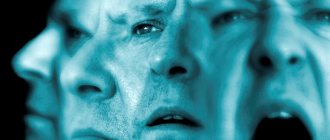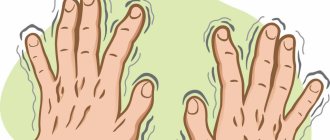This type of mental illness may also be called psychosis or paranoid symptom in medical practice. It is characterized by the presence of delusions in the patient, which are characterized by systematization. The patient is convinced that there is something false. At the same time, the perceived false is devoid of imagination and whimsicality. Among the manifestations there are the following variants of delirium:
- jealousy;
- persecution;
- dysmorphophobia;
- sensations of unrequited love and others.
Often the perceived manifestations are noticeably exaggerated or completely untrue. Diagnosis of the pathology is complicated by the variability of manifestations. Experts identify several of the most common manifestations.
General information
The state of delirium is a thinking disorder in which ideas, conclusions, and reasoning arise that do not correspond to reality. The patient is completely convinced of his conclusions and judgments and cannot be corrected. As evidenced by Wikipedia and other sources, delusional disorder is a component of symptoms in schizophrenia and other psychoses . Together with hallucinations, delusions belong to the group of “psychoproductive symptoms.”
Delirium is a thought disorder and a symptom of brain damage. Such thinking disorders in psychiatry are classified as pathological judgments. Experts note that delusions are egocentric and affective. Delirium can be treated using methods that act directly on the brain.
Doctors note that in colloquial language the word “delirium” is used in a meaning that differs from the psychiatric one. Therefore, from a scientific point of view, in this case this definition is used incorrectly. What types of delirium exist, as well as how to treat this condition, will be discussed in this article.
Delusional disorders in the elderly
The appearance of delusional disorders in the elderly is often associated with traumatic situations associated with the decline of the body. The most common symptom is the idea of damage; ideas of persecution of different directions are formed. There may be unmotivated complaints about the poor attitude of relatives.
In old age, the occurrence of pathology is often associated with an imbalance of substances responsible for transmitting signals in brain cells of neurotransmitters. In old age, patients often suffer from symptoms of several delusional disorders at once. They rarely manifest themselves in an acute form and usually have a chronic course. Auditory hallucinations associated with delusional symptoms often occur.
The course of therapy necessarily includes a combination of medications and psychotherapy. The pathology can be treated quite successfully, but in some situations, doctors may recommend going to a nursing home, where the elderly patient can receive constant care.
Classification
Depending on the development mechanism, there are:
- Primary – it is based on a violation of abstract cognition. It is also called interpretive delusion . It is often a chronic disorder and can persist throughout life. In this case, the primary defeat of thinking occurs. The patient's rational, logical cognition is affected. His distorted judgments are supported by subjective evidence, which is built into its own system. This delusional disorder is characterized by persistence, as well as progression in the process. There is a systematization of “evidence”: in the patient’s mind they form a stable system, and what does not fit into it can be ignored.
- Secondary - it is also called sensual and figurative . In this case, sensory cognition is disrupted, and the person perceives reality illusorily. Delusions are unsystematic, inconsistent and changeable. It may contain ideas with opposite meanings. Delusional ideas are not substantiated and do not have logical constructions. The actions of such a patient are often impulsive. With sensual delirium, its plot is visual, specific and emotionally vivid. With figurativeness, scattered, fragmentary ideas are noted, similar to fantasies or memories.
- Delusion of imagination - some experts distinguish it as this disorder is different from interpretative and sensory. In this case, delusional ideas are based on fantasy and intuition.
According to the content of delirium, the following forms are distinguished:
- With low self-esteem.
- With increased self-esteem.
- Persecutory (delusions of persecution).
- Mixed forms - persecutory delusions with increased or decreased self-esteem. In turn, this form is further divided into a number of subspecies with different symptoms.
Different types of delirium are defined depending on the characteristics of its manifestation. In modern medicine, the following types of mental disorder are distinguished:
- Acute delirium - it is defined if such a state completely takes over consciousness.
- Encapsulated - in this case, the patient adequately analyzes the surrounding reality if it does not relate to the topic of his delirium.
- Hallucinatory – develops as a result of impaired perception. It is dominated by hallucinations and illusions. At the same time, ideas are inconsistent and fragmentary, sensory cognition is disrupted. The thinking disorder is secondary. The patient has a delusional interpretation of hallucinations and no conclusions.
According to the dynamics of development, the following types of delirium are distinguished:
- Systematized - in order to confirm his own thoughts, the patient provides numerous interrelated evidence. He can clearly answer all questions regarding his morbid ideas. Since it takes time to form such a stable evidentiary connection, this type of delusion is long-term and chronic.
- Unsystematized - acute delirium that arises, devoid of a coherent system of manifestation and evidence. However, it can occur not only in acute psychoses. Patients talking about their fantastic ideas do not support them with anything.
According to the degree of manifestations, they are distinguished:
- Delirium of a small scale (domestic relationships) - as a rule, manifests itself in psychosis in older people.
- Megalomaniac (delirium of enormity) – the patient expresses the most fantastic ideas.
- Delusions of grandeur - manifested by the fact that a person insists on the uniqueness of his abilities. Those who exhibit delusions of grandeur may call themselves “the world’s greatest scientists,” “the creators of all life,” etc.
There are also special forms of this condition:
- Induced delusion - develops as a result of communication with a close relative who has a mental illness. The latter is the inductor, whose wild ideas (which, as a rule, are relatively plausible) are taken for granted by the inductee. Inducible delusions manifest themselves in those who perceive the inductor as a very authoritative person, as well as in people with congenital mental disorders (hysteria, infantility, suggestibility, etc.). This condition is not permanent and goes away as the situation changes.
- Residual - develops after suffering acute psychosis with clouded consciousness. The person is confident that everything he experienced in a painful state was reality.
- Highly valuable ideas are judgments that arise on the basis of real facts. In the patient’s mind they are overestimated and exaggerated. The patient does not treat his beliefs critically; such judgments occupy a dominant place in his thinking. An example of such ideas could be ideas of persecution, jealousy, fanatical religious beliefs, etc.
- Obsessions are spontaneously occurring obsessive pathological ideas to which a person is critical. Similar ideas are usually observed in patients with neurotic pathologies. However, they also occur in healthy people.
- Obsessive fears (phobias) - with this disorder, a person has a pathological fear of certain things or phenomena. In people with neuroses , they are most often closely connected with reality. For example, claustrophobia is the fear of closed spaces, thanatophobia is the fear of death, etc. The most common fear is fear of serious illnesses ( nosophobia ).
Delusional syndromes
There are three main delusional syndromes:
- Paranoid syndrome is a systematized interpretive delusion.
- Paranoid syndrome is unsystematized; as a rule, hallucinations and other disorders occur.
- Paraphrenic syndrome is systematized, fantastic, hallucinations and mental automatisms appear.
Treatment of delusional disorder
An important feature of therapy is contacting a specialist. Only a high-level professional is able to adequately convince a patient of the unreality of his ideas.
It is for this reason that psychotherapy courses play a leading role:
- individual;
- family;
- group.
During the course, the psychiatrist and psychotherapist jointly develop a course of procedures focused on the characteristics of each individual patient.
In cases where delusional disorders are severe, medications may be prescribed. The main place on this list is occupied by antidepressants and antipsychotics. If possible, the doctor tries to give up medications in favor of folk remedies, physiotherapy, and massages. Patients are recommended to take long walks and exercise. An effective way is to choose a new hobby, a hobby that distracts you from hallucinations and delusional thoughts. Such gentle therapy is recommended in the early stages of pathology.
Causes
The development of this mental disorder is influenced by a number of predisposing factors:
- genetic – a predisposition to certain mental illnesses, which is inherited;
- physiological – organic damage to the nervous system;
- biological – imbalance of neurotransmitters in the brain;
- psychological – stress, other psychological imbalances;
- social – alcoholism , drug addiction, drug abuse, etc.
Delusional schizophrenia-like disorder often develops due to a genetic predisposition. It may also be related to biological and environmental factors. Schizophrenia-like disorder can manifest itself due to a variety of reasons, the most common of which are the following:
- Temporal lobe epilepsy .
- Neuroinfections - encephalitis , neurosyphilis , etc.
- Tumor lesions of the brain (late stages).
- Traumatic brain injuries.
- Vascular diseases of the brain - severe form of cerebral atherosclerosis , cerebral thromboangiitis , hypertension .
- Toxic effects of drugs.
- Alcohol abuse or drug addiction.
- The influence of toxins .
- Somatic pathologies in which the nervous system is involved in the pathological process (in rare cases).
Organic delusional disorder
The specificity of this variant of delusional personality disorder is a serious physiological disorder associated with the presence of focal lesions in the temporal and parietal regions of the brain, temporal lobe epilepsy. A common cause is previous encephalitis. This pathology also includes epileptic psychoses that are not accompanied by impaired consciousness. It is distinguished by specialists as a separate type of pathology.
Often accompanied by hallucinatory-delusional attacks. With them, patients lose control over aggressive impulses. Accompanied by unmotivated actions and other manifestations of instinctive behavior.
At the moment, doctors are not able to accurately determine the cause of the onset of manifestations. Observations have shown that the onset of the disease may be equally associated with bilateral genetic predisposition and damage to specific brain structures. Delusional disorders in this pathology can be acute or transient organic.
Regardless of the type, the onset is characterized by an acute onset, accompanied by symptoms such as hallucinations, perception disorders, and delusions. There is a severe disturbance in everyday behavior. Often the trigger is serious stress experienced by the patient up to 1-2 weeks before the incident.
Symptoms
Symptoms of delusion are expressed, first of all, by the fact that the patient believes in false judgments, conclusions and conclusions, taking them for reality. Delirium occurs due to a specific disease and is its manifestation. Symptoms depend on the type of delirium. Organic delusional disorder is a condition characterized by the presence of dominant, well-systematized delusions in the patient. However, unlike schizophrenia, organic schizophrenia-like disorder does not have strong psychotic manifestations. The main manifestation that characterizes chronic delusional disorder is delusion. An organic disorder can manifest itself in various delusional ideas with different plots. Despite the fact that chronic schizophrenia-like disorder manifests itself with symptoms typical of schizophrenia, it does not lead to the development of a schizophrenic defect.
The plot of delirium
The plot of delirium is its content, according to which one or another of its varieties is determined. In the case of interpretative delusions, the plot is not a sign of illness and depends on a number of factors influencing the patient - cultural, social, psychological, etc. There can be many plots, but most often ideas arise that can be generalized into three groups of delusional states.
Paranoid
In this case, the person is sure that he is being influenced by an external unfavorable influence. This type includes:
- Delusion of persecution (persecutory delusion) - a person thinks that he is being watched or being pursued. Symptoms of delusions of persecution are sometimes manifested by the fact that the patient is convinced that there is a certain conspiracy theory with the aim of causing him any harm. The persecutory type of delusional disorder leads to the fact that the patient suspects close people, neighbors, colleagues, etc. of persecution.
- Delusion of damage is the belief that someone is deliberately damaging the patient’s property or stealing things. As a rule, people who communicate with the patient in everyday life are suspected of this.
- Delusion of relation - a person is sure that the whole reality that surrounds him is directly related to him. It seems to him that all conversations and actions of other people are connected with a special attitude towards him.
- Delusion of influence - a person is sure that they are trying to influence him physically (with devices or rays), mentally, etc.
- Delusions of jealousy – this condition is also called “Othello syndrome.” Pathological delusions of jealousy in men can manifest themselves against the background of alcoholism, drug addiction, schizophrenia and other diseases that are not treated correctly. More often, pathological jealousy is observed in men, which is manifested by delusional ideas of infidelity, constant suspicion, and fixation on the personality of the partner. Often men also make aggressive attacks towards their partner. Pathological jealousy is less common in women. Most often, this pathology is observed in women with alcohol addiction. Characteristic signs of Othello syndrome are attacks of aggression and psychosis.
- Delusion of staging (intermetamorphosis) - the patient is convinced that everything around him is specially arranged and some kind of performance is being played out.
- Paraphrenic delusion – the patient has a combination of fantastic and delusional ideas, usually of greatness and persecution.
There are other types of delusional disorders of this type.
Delusions of grandeur ("megalomaniac")
This category includes the following types of delusional disorders:
- Delusion of origin - a person is convinced that in fact his parents are high-ranking people, that he comes from a noble family, etc.
- Delirium of invention - a person promotes various unrealistic projects, passing them off as real inventions.
- Delusion of eternal life - the patient is sure that he will live forever.
- Delusions of love - manifests itself more often in women. Its essence is the belief that the patient is loved by a famous person, or that everyone falls in love with him. Delusions of love can lead to the patient unceremoniously invading someone's relationship.
- Religious nonsense - a person is sure that he can perform miracles, considers himself a prophet.
Depressive delirium
- Hypochondriacal or somatic delusion - a person is convinced that he is sick with some serious illness.
- Dermatozoan delusion - a person is convinced that he is infected with parasites, although he has no signs of infestation.
- Delusion of inferiority - the patient is convinced that he is physically or mentally inferior.
- Nihilistic delusions - manifested in psychotic bipolar disorder. In this case, the patient has a false feeling that the world around him or himself does not exist.
- Cotard's delusion - manifests itself in patients with Cotard's syndrome. Such people have delusional ideas filled with hypochondriacal and nihilistic vivid beliefs against the background of a melancholy and anxious affective state. For example, people who exhibit Cotard's delirium may complain that they have no heart, that they have infected everyone with a serious illness, that they have died a long time ago. Such patients develop the belief that everything is lost, the world is empty.
There are other types of delusional disorder that are associated with certain medical conditions. For example, in people suffering from alcoholism, drunken delirium, etc., may appear as a symptom.
If we talk about the general features of the manifestation of delusional disorder, then the following signs should be noted:
- Occurs as a sign of a certain disease.
- It is characterized by paralogicality - construction on the basis of internal logic, based on the internal needs of the human psyche.
- There is no impairment of consciousness.
- Ideas do not correspond to objective reality, but the patient is convinced of their reality.
- Resistance of ideas to correction, immutability of beliefs.
- Intelligence is maintained or weakened insignificantly.
- There are profound personality changes provoked by fixation on a delusional idea.
The difference between the delusions of a schizophrenic and those of healthy people
Delusional ideas arise as a result of mental illness, so their nature is not similar to the erroneous opinions and beliefs that people with a healthy psyche have.
- Delusional ideas are characterized by an erroneous, distorted view of reality.
- Delusion is unshakable, that is, the patient’s ideas cannot be corrected. Attempts to enter into a dispute, to argue, to prove only strengthen it.
- The patient is convinced of the reality of delusional experiences.
- Delusions are characterized by initially incorrect grounds (so-called paralogics).
- Most often (with rare exceptions), delusional ideas arise against the background of clear consciousness.
- Delirium is always accompanied by noticeable changes in the patient’s personality (his attitude towards himself and others changes).
- Against the backdrop of the appearance of delusional ideas, intelligence does not decrease. On the contrary, delusions are more often observed in patients with high IQ levels.
Tests and diagnostics
To establish a diagnosis, it is necessary to conduct a comprehensive examination. If necessary, psychiatric, instrumental, and laboratory diagnostic methods are used. Initially, the doctor interviews the patient or his relatives to find out about symptoms, previous injuries and illnesses, as well as other factors that could affect the patient’s condition. Next, laboratory blood tests are performed to determine signs of infection, levels of vitamins and electrolytes, the presence of toxic substances, etc.
A thyroid function test, electrocardiogram, CT, MRI and other studies may be performed.
It is important to distinguish delusions from delusions of people who are mentally healthy. To do this, the doctor takes into account several important facts. So, for the appearance of delusional ideas there must be pathological reasons, that is, diseases. In addition, delusions, unlike delusional ideas, are associated with objective circumstances. Misconceptions can also be corrected. Delusional ideas contradict a person’s previous worldview - when he was healthy, such conclusions were not characteristic of him. However, psychiatrists note that differential diagnosis is often difficult.
Basic scenarios of distorted consciousness
Medicine identifies three common scenarios for distorted perception. These are paranoid, paranoid and paraphrenic syndromes.
With paranoid syndrome, hallucinations and adherence to one topic are observed.
Paranoid syndrome is characterized by fixation on one topic; outside of it, a person’s thinking remains undistorted.
Paraphrenic syndrome is characterized by a person’s fanatical conviction and systematic distortion of perception.
Prevention
Methods for preventing the manifestation of such disorders are currently unknown. The only important aspect of prevention is early diagnosis of the disease that provoked such symptoms.
As for preventing the manifestation of such disorders in patients with mental disorders, the following preventive measures can be provided to them:
- Performing light exercise.
- Listening to relaxing music.
- Drink enough fluids to prevent dehydration.
Delusional relationship
One of the most characteristic and common among schizophrenics. This is a type of persecutory or paranoid delusion. Delusions of attitude can manifest themselves in the following ideas. The patient is convinced that everything that happens around him is directly related to him, that the attention of others is focused only on him. It seems to such patients that everyone is discussing them, they discover a threat to themselves in the grin of a random passer-by, some even take the news broadcast on TV personally.
Delusions of relation in schizophrenics often develop into delusions of meaning. At this stage, the patient is not only sure that “the world revolves around him,” he can explain why.
Features of schizophrenic delusions
Delusions occur not only in schizophrenia, but also in other mental disorders. Experts identify a number of signs that can be considered characteristic of schizophrenic delusions.
- Delusions are almost always combined with hallucinations.
- There is often ambiguity and inconsistency in the patient's beliefs.
- An outbreak of delusional experience. A schizophrenic is suddenly struck by a delusional thought.
- Absurd formulation of the idea. As a rule, the patient formulates his thoughts very abstractly and vaguely. Individual fragments of thoughts are difficult to fit into a single whole.
- The delirium gradually becomes more and more vague, the patient withdraws into himself, breaks off all social contacts, and lives in the world of his fantasies.
How are they treated?
Treatment of delirium as a symptom of schizophrenia is carried out comprehensively. Therapy methods are selected for each patient individually, taking into account the clinical picture and stage of the disease. Treatment is usually carried out in several stages. First, in a hospital setting, an acute attack is stopped and the patient’s condition is stabilized. Then they prepare him for discharge and return to everyday life. The next stages are rehabilitation, which takes about a year, and prevention, which can last for decades. For people with schizophrenia, the support of loved ones is very important. It is the relatives who must ensure that the patient does not violate the doctor’s recommendations, takes medications strictly according to schedule, and helps control behavior.
The appearance of delusional ideas may be one of the first symptoms of schizophrenia. And if you pay attention to the changed behavior of a loved one in time, immediately go to the doctor and start treatment early, you can maintain a decent quality of life for the patient for many years.








